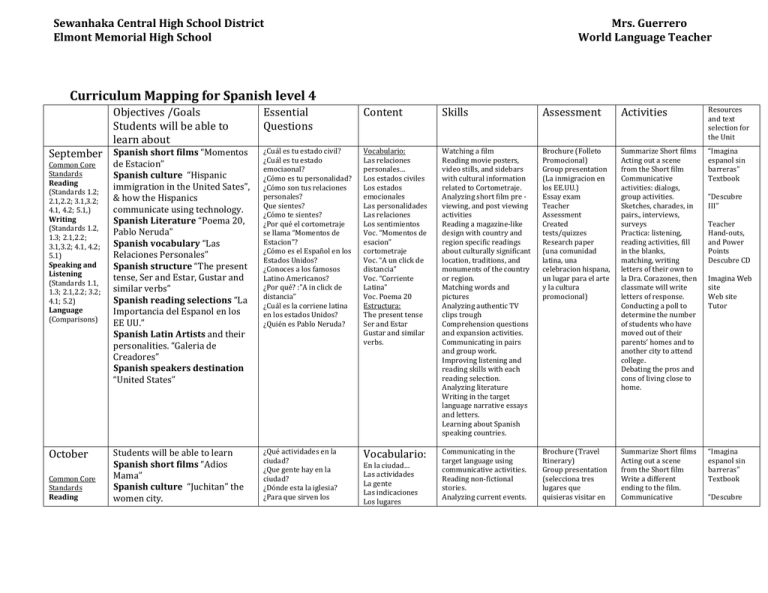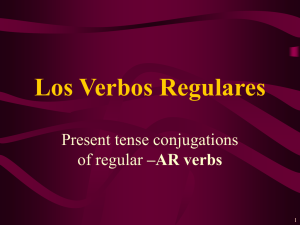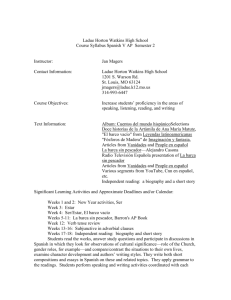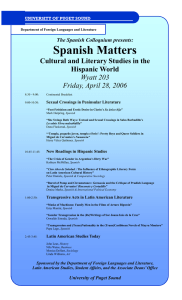Temas para el Ano Escolar Spanish 4
advertisement

Sewanhaka Central High School District Elmont Memorial High School Mrs. Guerrero World Language Teacher Curriculum Mapping for Spanish level 4 Objectives /Goals Students will be able to learn about September Spanish short films “Momentos Common Core Standards Reading (Standards 1.2; 2.1,2.2; 3.1,3.2; 4.1, 4.2; 5.1,) Writing (Standards 1.2, 1.3; 2.1,2.2; 3.1,3.2; 4.1, 4.2; 5.1) Speaking and Listening (Standards 1.1, 1.3; 2.1,2.2; 3.2; 4.1; 5.2) Language (Comparisons) de Estacion” Spanish culture “Hispanic immigration in the United Sates”, & how the Hispanics communicate using technology. Spanish Literature “Poema 20, Pablo Neruda” Spanish vocabulary “Las Relaciones Personales” Spanish structure “The present tense, Ser and Estar, Gustar and similar verbs” Spanish reading selections “La Importancia del Espanol en los EE UU.” Spanish Latin Artists and their personalities. “Galeria de Creadores” Spanish speakers destination “United States” October Students will be able to learn Spanish short films “Adios Mama” Spanish culture “Juchitan” the women city. Common Core Standards Reading Essential Questions Content Skills Assessment Activities Resources and text selection for the Unit ¿Cuál es tu estado civil? ¿Cuál es tu estado emociaonal? ¿Cómo es tu personalidad? ¿Cómo son tus relaciones personales? Que sientes? ¿Cómo te sientes? ¿Por qué el cortometraje se llama “Momentos de Estacion”? ¿Cómo es el Español en los Estados Unidos? ¿Conoces a los famosos Latino Americanos? ¿Por qué? :”A in click de distancia” ¿Cuál es la corriene latina en los estados Unidos? ¿Quién es Pablo Neruda? Vocabulario: Las relaciones personales… Los estados civiles Los estados emocionales Las personalidades Las relaciones Los sentimientos Voc. “Momentos de esacion” cortometraje Voc. “A un click de distancia” Voc. “Corriente Latina” Voc. Poema 20 Estructura: The present tense Ser and Estar Gustar and similar verbs. Watching a film Reading movie posters, video stills, and sidebars with cultural information related to Cortometraje. Analyzing short film pre viewing, and post viewing activities Reading a magazine-like design with country and region specific readings about culturally significant location, traditions, and monuments of the country or region. Matching words and pictures Analyzing authentic TV clips trough Comprehension questions and expansion activities. Communicating in pairs and group work. Improving listening and reading skills with each reading selection. Analyzing literature Writing in the target language narrative essays and letters. Learning about Spanish speaking countries. Brochure (Folleto Promocional) Group presentation (La inmigracion en los EE.UU.) Essay exam Teacher Assessment Created tests/quizzes Research paper (una comunidad latina, una celebracion hispana, un lugar para el arte y la cultura promocional) Summarize Short films Acting out a scene from the Short film Communicative activities: dialogs, group activities. Sketches, charades, in pairs., interviews, surveys Practica: listening, reading activities, fill in the blanks, matching, writing letters of their own to la Dra. Corazones, then classmate will write letters of response. Conducting a poll to determine the number of students who have moved out of their parents’ homes and to another city to attend college. Debating the pros and cons of living close to home. “Imagina espanol sin barreras” Textbook ¿Qué actividades en la ciudad? ¿Que gente hay en la ciudad? ¿Dónde esta la iglesia? ¿Para que sirven los Vocabulario: Communicating in the target language using communicative activities. Reading non-fictional stories. Analyzing current events. Brochure (Travel Itinerary) Group presentation (selecciona tres lugares que quisieras visitar en Summarize Short films Acting out a scene from the Short film Write a different ending to the film. Communicative “Imagina espanol sin barreras” Textbook En la ciudad… Las actividades La gente Las indicaciones Los lugares “Descubre III” Teacher Hand-outs, and Power Points Descubre CD Imagina Web site Web site Tutor “Descubre (Standards 1.2; 2.1,2.2; 3.1,3.2; 4.1, 4.2; 5.1,) Writing (Standards 1.2, 1.3; 2.1,2.2; 3.1,3.2; 4.1, 4.2; 5.1) Speaking and Listening (Standards 1.1, 1.3; 2.1,2.2; 3.2; 4.1; 5.2) Language (Comparisons) November Common Core Standards Reading (Standards 1.2; 2.1,2.2; 3.1,3.2; 4.1, 4.2; 5.1,) Spanish Literature “Aqueronte, Jose Emilio Pacheco” Spanish vocabulary “The City Life” Spanish structure “The preterite, the imperfect, the preterite vs. the imperfect. Spanish reading selections “te gusta viajar?” Spanish Latin Artists and their personalities. “Galeria de Creadores” Spanish destination “Mexico” Spanish Flash Culture “Taxco la ciudad de los ciclistas” Students will be able to learn Spanishshort film“Encrucijada” Spanish culture“Los Ritmos del Caribe” Spanish Literature “Aqueronte, Jose Emilio Pacheco” Spanish vocabulary “La Influencia de los Medios” Spanish structure “The preterite, the imperfect, the preterite vs. the imperfect. Spanish reading selections “te gusta viajar?” Spanish Latin Artists and their personalities. “Galeria de Creadores” Spanish destination “Mexico” Spanish Flash Culture “Taxco la ciudad de los ciclistas” medios de comunicacion? ¿Quiénes son los profesionales de los medios? ¿Qué hacen el cine y la televisión? ¿Qué hace la prensa? ¿Estamos informados o hipnotizados por los medios de comunicacion? ¿Cómo es Mexico? ¿Quiénes forman parte de la Galeria de creadores de Mexico? ¿Por qué el cortometraje se titular “Adiós mamá? ¿Por qué hay una locura en bicicletas en Down Taxco? ¿Quiénes son las mujeres de Juchitan? ¿Quién fue Frida y Diego Rivera? ¿Quién es Jose Emilio Pacheco? ¿Cómo es El Cribe: Cuba, Puerto Rico, y la Republica Dominicana? ¿Qué es el Coqui? ¿Conoces la galleria de creadores del Caribe? ¿Cuáles son los ritmos del Caribe? Voc. Adios mama: cortometraje Voc. Down Taxco: locura en bicicletas En Pantalla Voc. Juchitan: La ciudad de las mujeres” Voc. Aqueronte, cuento Vocabulario: Los medios de comunicacion…… El cine y la television Los medios La prensa Los profesionales de los medos Voc. Encrucijada: cortometraje Voc. En pantalla: Alerta Verde: coqui en peligro de extinction Voc. “Ritmos del Caribe” Voc. La desesperacion de las letras” cuento Estructura The preterite The imperfect The preterite vs. the imperfect Commands The Subjuntive in noun clauses. Mexico) Essay exam Teacher Assessment Created tests/quizzes Research paper (Aventuras en el Caribe) (Mi Comunidad) Relection paper on movie. Students write the script for a play, soap opera, documentary or talk show. activities: dialogs, group activities. Sketches, charades, in pairs., interviews, surveys Practica: Listening, reading activities. Fill in the blanks, matching, writing letters Compare practices in Mexico vs. United States (Compare the description of Juchitan to their previous ideas about what constitutes a matriarchal society. Listen to excerpts from several Spanish artists and discuss the genre of each song and the instruments used. Watch music video clips for students to analyze the lyrics, critique the video and find meaning of the song. Write a police story And read the story to the class. Students will discover the mystery. Write an e-mailed III” Teacher Hand-outs, worksheets and Power Points Descubre CD Imagina Web site Web site Tutor Writing (Standards 1.2, 1.3; 2.1,2.2; 3.1,3.2; 4.1, 4.2; 5.1) Speaking and Listening (Standards 1.1, 1.3; 2.1,2.2; 3.2; 4.1; 5.2) Language (Comparisons) December Common Core Standards Reading (Standards 1.2; 2.1,2.2; 3.1,3.2; 4.1, 4.2; 5.1,) Writing (Standards 1.2, 1.3; 2.1,2.2; 3.1,3.2; 4.1, 4.2; 5.1) Speaking and Listening (Standards 1.1, 1.3; 2.1,2.2; 3.2; 4.1; 5.2) Language (Comparisons) January Students will be able to learn Spanishshort film“En el Rincon de Venezuela” Spanish culture “ La herencia de los mayas ” Spanish Literature “El eclipse, Augusto Monterroso” Spanish vocabulary “Generaciones en movimiento” Spanish structure “ Reflexive Verbs and Subjunctive” Spanish reading selections “La carretera Panamericana” Spanish Latin Artists and their personalities. “Galeria de Creadores” Spanish destination “Centroamerica” Spanish Flash Culture “El turismo en Nicaragua” ¿Quién es Gines S. Cutillas? ¿Quiénes fueron las hermanas Mirabal? ¿De qué trata “In the Time of the butterflies”? ¿Cuáles son las etapas de la vida? ¿Qué son las generaciones? ¿Cómo son tus parientes? ¿Cómo es la personalidad de tu familia? ¿Cómo es tu vida familiar? ¿De qué trata el cortometraje: “El Rincon de Venezuela? ¿Cómo es Centroamerica: Costa Rica, El Salvador, Guatemala, Honduras, Nicaragua, y Panama? ¿Quiénes forman parte de la galeria de creadores de Centro America? ¿Por qué el turismo es un aporte y un desafio? ¿Cuál es la herencia de los mayas? ¿Quién es Augusto Monterroso? Vocabulario En familia…. Las etapas de la vida Las generaciones Los parientes La personalidad La vida familiar Voc. “El Rincon de Venezuela”corto.. Voc. En Pantalla: Turismo: aportes y desafios Voc. La herencia de los mayas Voc. El eclipse. Cuento Estructura Reflexive verbs The Subjunctive in adjective clauses Watching a film Reading movie posters, video stills, and sidebars with cultural information related to cortometraje. Analyzing pre viewing, and post viewing activities to check comprehension Reading a magazine-like design with country and region specific readings about culturally significant location, traditions, and monuments of the country or region. Matching words and pictures Analyzing authentic TV clips trough comprehension questions and expansion activities. Communicating in pairs and group work. Improving listening and reading skills with each reading selection. Analyzing literature Writing in the target language narrative essays and letters. Learning about Spanish speaking countries. Proyecto (Odisea por Centro America) Group presentation (La Cultura Maya) Essay exam Teacher Assessment Created tests/quizzes Research paper (La Panamericana) Summarize Short films Acting out a scene from the Short film Communicative activities: dialogs, group activities. Sketches, charades, in pairs., interviews, surveys Practica: Listening activities, reading activities, fill in the blanks, matching, writing letters Prepare oral presentations about their own families, using photographs or other visual aids Debating “Brecha generacional” For oral practice, in groups students will give short presentations on Mayan influence in the following areas: la astronomia, la comida, la lengua espanola, la religion, la arquitectura. Tell an anecdote about their families “Imagina espanol sin barreras” Textbook “Descubre III” Teacher Hand-outs, and Power Points Descubre CD Imagina Web site Web site Tutor January Common Core Standards Reading (Standards 1.2; 2.1,2.2; 3.1,3.2; 4.1, 4.2; 5.1,) Writing (Standards 1.2, 1.3; 2.1,2.2; 3.1,3.2; 4.1, 4.2; 5.1) Speaking and Listening (Standards 1.1, 1.3; 2.1,2.2; 3.2; 4.1; 5.2) Language (Comparisons) February Common Core Standards Reading (Standards 1.2; 2.1,2.2; 3.1,3.2; 4.1, 4.2; 5.1,) Writing (Standards 1.2, 1.3; 2.1,2.2; 3.1,3.2; 4.1, 4.2; 5.1) Speaking and Listening (Standards 1.1, 1.3; 2.1,2.2; 3.2; Students will be able to learn Spanishshort film“Raiz” Spanish culture “ La cordillera de los incas” Spanish Literature “Buscas la felicidad?, Jaime Sabines” Spanish vocabulary “Las riquezas naturales” Spanish structure “The Future tense and the conditional. Spanish reading selections “La selva amazonica biodiversidad curativa?” Spanish Latin Artists and their personalities. “Galeria de Creadores” Spanish destination “Colombia, Ecuador y Venezuela” Spanish Flash Culture “La flora y la fauna del valle del rio Mindo” ¿Sabes los nombres de estos animales en espanol? ¿Qué es la ecologia? ¿Por qué es importante saber de leyes y derechos? ¿Qué fenomenos naturales existen? ¿Qué hay en la naturaleza? ¿Por qué el cortometraje se titular “Raiz”? ¿Por qué debemos preservar la selva amazónica? ¿Quién es Jaime Sabines? Vocabulario: Nuestro mundo…. Los animals La ecologia Los fenomenos naturales La naturaleza Vocabulario del cortometraje “Raiz” Voc. En Pantalla: de aventura por Mindo.. Voc. La Selva Amazonica: Biodiversidad curativa…. Voc. La Luna…..Poesia Estructura; The future The conditional Communicating in the target language using communicative activities. Reading non-fictional stories. Analyzing current events. Proyecto (revista de ecoturismo) Group presentation (La Selva Amazonica) Essay exam Teacher Assessment Created tests/quizzes Research paper (Oswaldo Guayasamin) Proyect #2 “Mi Futuro” Summarize Short films Acting out a scene from the Short film Communicative activities: dialogs, group activities. Sketches, charades, in pairs, interviews, surveys Practica: Listening, reading, and writing activities. Fill in the blanks, matching, writing letters. Write postcards Write ads Write suggestions, and recomendations “Imagina espanol sin barreras” Textbook “Descubre III” Teacher Hand-outs, and Power Points Descubre CD Imagina Web site Web site Tutor 4.1; 5.2) Language (Comparisons) March Common Core Standards Reading (Standards 1.2; 2.1,2.2; 3.1,3.2; 4.1, 4.2; 5.1,) Writing (Standards 1.2, 1.3; 2.1,2.2; 3.1,3.2; 4.1, 4.2; 5.1) Speaking and Listening (Standards 1.1, 1.3; 2.1,2.2; 3.2; 4.1; 5.2) Language (Comparisons) April Common Core Standards Reading Students will be able to learn Spanish short film“Un Pedazo de Tierra” Spanish culture “Espana – Confluencia de Civilizaciones” Visitemos Espana! Spanish Literature “Algo muy grave va a suceder en este pueblo” Gabriel Garcia Marquez Spanish vocabulary “Nuestro Mundo” Spanish structure “The Present Subjunctive, The Passive Voice” Spanish reading selections “Espana Nueva Ola de Inmigrantes” Spanish Latin Artists and their personalities. “Galeria de Creadores” Spanish destination “España” Spanish Flash Culture “¿Quién quiere ser millonario?” ¿Qué cambios te gustaría hacer para el futuro? ¿Habrán mas problemas y soluciones en nuestro futuro? ¿Cuáles son las tendencias futuras? Heritage and Destiny ¿Cómo es España? ¿Quiénes forman parte de la galeria de creadores modernos de España? Vocabulario Nuestro Mundo… Los cambios Los problemas y las soluciones Las tendencias Voc. Un pedazo de tierra…Cortometra.. Voc. EN PANTALLA: quien quiere ser millonario? Voc. Espana: Nueva Ola de inmigrantes.. Voc. “Algo muy grave va a suceder en este pueblo…CUENTO Watching a film Reading movie posters, video stills, and sidebars with cultural information related to cortometraje. Analyzing pre -viewing, and post viewing activities to check comprehension Reading a magazine-like design with country and region specific readings about culturally significant location, traditions, and monuments of the country or region. Matching words and pictures Analyzing authentic TV clips trough comprehension questions and expansion activities. Communicating in pairs and group work. Improving listening and reading skills with each reading selection. Analyzing literature Writing in the target language narrative essays and letters. Learning about Spanish speaking countries. Voc. El Quijote de la Mancha” Estructura Present Subjunctive Communicating in the target language using communicative activities. Reading non-fictional Proyecto (La arquitectura de Espana) Group presentation (Visitemos Espana) Essay exam Teacher Assessment Created tests/quizzes Research paper (Espana Nueva ola de Inmigrantes) Proyecto 2 Artistas de Espana Summarize Short films Acting out a scene from the Short film Communicative activities: dialogs, group activities. Sketches, charades, in pairs., interviews, surveys Practica: Listening activities, reading activities, fill in the blanks, matching, writing letters Guide to debate by asking students’ opinions about controversial topics such as bilingual education, illegal inmigration, and the enforcement of an official language.” Rewrite another version of “Algo muy grave va a suceder en este pueblo” Presentations on different cities of Spain and its culture. Analyzing the movie “VOLVER” and the different main topics in the movie. Give the movie a different ending. “Imagina espanol sin barreras” Textbook “Descubre III” Teacher Hand-outs, and Power Points Descubre CD Imagina Web site Web site Tutor (Standards 1.2; 2.1,2.2; 3.1,3.2; 4.1, 4.2; 5.1,) Writing (Standards 1.2, 1.3; 2.1,2.2; 3.1,3.2; 4.1, 4.2; 5.1) Speaking and Listening (Standards 1.1, 1.3; 2.1,2.2; 3.2; 4.1; 5.2) Language (Comparisons) May Common Core Standards Reading (Standards 1.2; 2.1,2.2; 3.1,3.2; 4.1, 4.2; 5.1,) Writing (Standards 1.2, 1.3; 2.1,2.2; 3.1,3.2; 4.1, 4.2; 5.1) Speaking and Listening (Standards 1.1, 1.3; 2.1,2.2; 3.2; 4.1; 5.2) Language (Comparisons) Students will be able to learn Spanish short film“El hombre que volaba un poquito” Spanish culture “Historia y Naturaleza! “Viaje por Bolivia y Paraguay” Spanish Literature “La Mirada” por Juan Madrid Spanish vocabulary “El trabajo y las finanzas” Spanish structure “The Present Subjunctive, The Passive Voice” Spanish reading selections “Recursos naturals: Una salida al mundo” Spanish Latin Artists and their personalities. “Galeria de Creadores” Spanish destination “Bolivia y Paraguay” Spanish Flash Culture “El gran carnaval de Oruro” ¿Quién quiere ser millonario? En Pantalla ¿Quién es Gabriel García Marquez? ¿Qué significa en el cortometraje “Un pedazo de tierra”? The passive voice stories. Analyzing current events. ¿Qué es un Hiyab y por qué se usa? ¿Que pasa en el cortometraje HIYAB? ¿Cómo es Chile? ¿Quiénes forman parte de la galeria de creadores de Chile? ¿Por qué el gobierno de Chile incentiva el uso de las bicicletas? ¿De qué trata Machuca? ¿Tenía Chile una dictadura y democracia a la vez? ¿Quién es Armando Valladares? ¿Qué es el mundo laboral? ¿Qué tiene que formar parte de la economia de un país? ¿Cuáles son las profesiones en el mundo de las finanazas? ¿De qué trata el cortometraje “el hombre que volaba un poquito”? ¿Cómo es Bolivia y Paraguay? ¿A quiénes nos presentan la Galeria de Creadores de Vocabulario El trabajo y las finanzas…. La economia La gente en el trabajo El mundo laboral Voc. “Machuca” Movie. Voc. EN PANTALLA “ el gran carnival de Oruro” Voc. ”Recursos naturales: una salida al mundo… Voc. La Mirada…CUENTO Estructura Uses of se Uses of the infinitive. Communicating in the target language using communicative activities. Reading non-fictional stories. Analyzing current events. Proyecto (Un final entre ruinas) Group presentation (Viaje por Bolivia y Paraguay) Essay exam Teacher Assessment Created tests/quizzes Research paper “Los recursos naturales de Bolivia y Paraguay” “Food Network Star” Summarize Short films Acting out a scene from the Short film Communicative activities: dialogs, group activities. Sketches, charades, in pairs., interviews, surveys Practica: Listening activities, reading activities, fill in the blanks, matching, writing letters Research Madidi National Park and write e-mails to friends describing what they have seen and done at the park. Describing a job interview they have had. Write a newspaper article. “Imagina espanol sin barreras” Textbook “Descubre III” Teacher Hand-outs, and Power Points Descubre CD Imagina Web site Web site Tutor Bolivia y Panama? ¿Cómo es el gran carnival de Oruro? ¿Por qué los recursos naturales son una salida al mundo? ¿Quién es Juan Madrid y de qué trata su cuento? June Common Core Standards Reading (Standards 1.2; 2.1,2.2; 3.1,3.2; 4.1, 4.2; 5.1,) Writing (Standards 1.2, 1.3; 2.1,2.2; 3.1,3.2; 4.1, 4.2; 5.1) Speaking and Listening (Standards 1.1, 1.3; 2.1,2.2; 3.2; 4.1; 5.2) Language (Comparisons) ¿De qué trata “La Casa de los Espiritus” ¿Sabes que estudiar para el examen final?. Voc. Speaking test Estructura Review Packet Communicating in the target language using communicative activities. Reading non-fictional stories. Analyzing current events. Speaking Test Post Assessment Final Exam “Imagina espanol sin barreras” Textbook “Descubre III” Teacher Hand-outs, and Power Points Descubre CD Imagina Web site Web site Tutor


